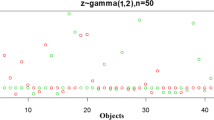Abstract
In this article, we propose a class of semiparametric transformation rate models for recurrent event data subject to right censoring and potentially stopped by a terminating event (e.g., death). These transformation models include both additive rates model and proportional rates model as special cases. Respecting the property that no recurrent events can occur after the terminating event, we model the conditional recurrent event rate given survival. Weighted estimating equations are constructed to estimate the regression coefficients and baseline rate function. In particular, the baseline rate function is approximated by wavelet function. Asymptotic properties of the proposed estimators are derived and a data-dependent criterion is proposed for selecting the most suitable transformation. Simulation studies show that the proposed estimators perform well for practical sample sizes. The proposed methods are used in two real-data examples: a randomized trial of rhDNase and a community trial of vitamin A.
Similar content being viewed by others
References
Andersen PK, Gill RD (1982) Cox’s regression model for counting processes: a large sample study. Ann Stat 10:1100–1120
Barreto ML, Santos LMP, Assis AMO, Araujo MPN, Farenzena GG, Santos PAB, Fiaccone BL (1994) Effect of vitamin A supplementation on diarrhoea and acute lower-respiratory-tract infections in young children in Brazil. Lancet 344:228–231
Cai T, Betensky RA (2003) Hazard regression for interval-censored data with penalized spline. Biometrics 59:570–579
Cai T, Hyndman R, Wand MP (2002) Mixed model-based hazard estimation. J Comput Graph Stat 11:784–798
Cheng SC, Wei LJ, Ying Z (1995) Analysis of transformation models with censored data. Biometrika 82:835–845
Cook RJ, Lawless JF (1997) Marginal analysis of recurrent events and a termination event. Stat Med 16:911–924
Ghosh D, Lin DY (2000) Nonparametric analysis of recurrent events and death. Biometrics 56:554–562
Ghosh D, Lin DY (2002) Marginal regression models for recurrent and terminal events. Stat Sin 12:663–688
Hardle W, Kerkyacharian G, Picard D, Tsybakov A (1998) Wavelets, approximation, and statistical applications. Lecture notes in statistics, vol 129. Springer, Berlin
Huang CY, Wang MC (2004) Joint modeling and estimation of recurrent event processes and failure time. J Am Stat Assoc 99(468):1153–1165
Kalbfleisch JD, Prentice RL (2002) The statistical analysis of failure time data, 2nd edn. Wiley, New York
Lawless JF, Nadeau C (1995) Some simple robust methods for analysis of recurrent events. Technometrics 37:158–168
Lin DY, Wei LJ, Yang I, Ying Z (2000) Semiparametric regression for the mean and rate function of recurrent events. J R Stat Soc B 711–730
Lin DY, Wei LJ, Ying Z (2001) Semiparametric transformation models for point processes. J Am Stat Assoc 96:620–628
Liu L, Wolfe RA, Huang X (2004) Shared frailty models for recurrent events and a terminal event. Biometrics 60:747–756
Pan W (2001) Akaike’s information criterion in generalized estimating equations. Biometrics 57:120–125
Pan Q, Schaubel DE (2009) Flexible estimation of differences in treatment-specific recurrent event means in the presence of a terminating event. Biometrics 65(3):753–761
Pepe MS, Cai J (1993) Some garphical displays and marginal regression analyses for recurrent failure times and time dependent covariates. J Am Stat Assoc 88:811–820
Schaubel DE, Zhang M (2010) Estimating treatment effects on the marginal recurrent event mean in the presence of a terminating event. Lifetime Data Anal 16:451–477
Schaubel DE, Zeng D, Cai J (2006) A semiparametric additive rates model for recurrent event data. Lifetime Data Anal 12:386–406
Therneau TM, Hamilton SA (1997) rhDNase as an example of recurrent event analysis. Stat Med 16:2029–2047
van der Vaart AW (1998) Asymptotic statistics. Cambridge University Press, Cambridge
Ye Y, Kalbfleisch JD, Schaubel DE (2007) Semiparametric analysis of correlated recurrent and terminal events. Biometrics 63:78–87
Author information
Authors and Affiliations
Corresponding author
Rights and permissions
About this article
Cite this article
Zeng, D., Schaubel, D.E. & Cai, J. Semiparametric Transformation Rate Model for Recurrent Event Data. Stat Biosci 3, 187–207 (2011). https://doi.org/10.1007/s12561-011-9043-4
Received:
Accepted:
Published:
Issue Date:
DOI: https://doi.org/10.1007/s12561-011-9043-4




